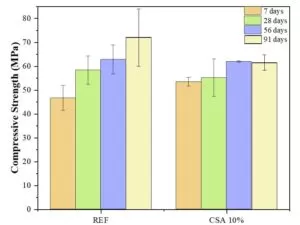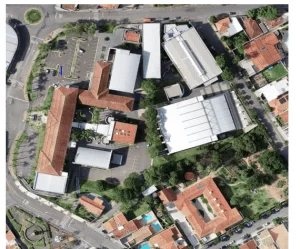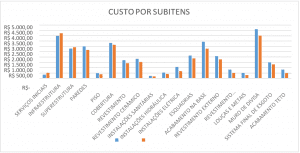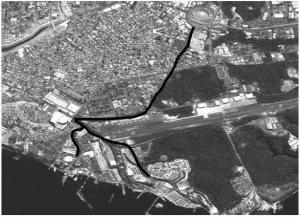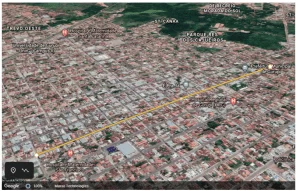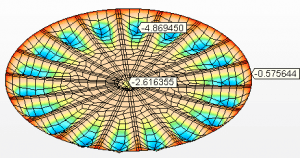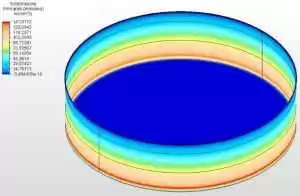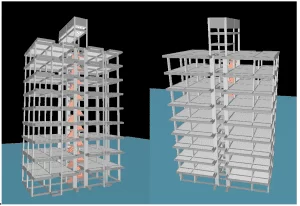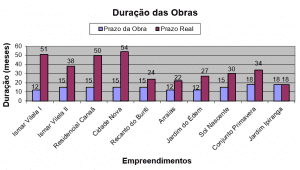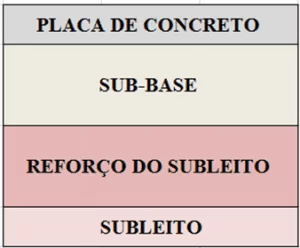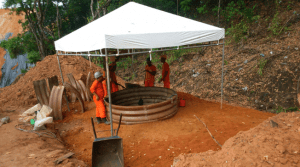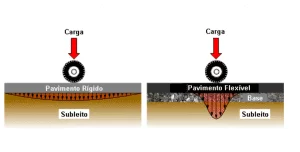MARQUES, Romena Andreia Charchar Campos [1]
MARQUES, Romena Andreia Charchar Campos. Proof of the PDCA Tool in the Coating Settlement Service. Multidisciplinary Scientific Journal. Edition 9. Year 02, Vol. 01. pp 64-70, December 2017. ISSN:2448-0959
ABSTRACT
The following work consists of a case study that demonstrates the efficiency of the PDCA tool in civil construction works, through its application in the ceramic tile laying service, in a multifamily residential building in the city of Belém / PA. The PDCA cycle, through the search for continuous improvement, leads to high quality final services, which is directly proportional to customer satisfaction, thus guaranteeing companies competitiveness in the real estate market. It is a model of planning, management and control, whose acronym comes from English: Plan, Do, Check, Act. It allows you to plan goals, put action, control and take action on failures, until the potential that is planned is achieved. The result of this research affirms the usefulness of the tool, since the percentage of non-compliance that reached 15%, at the end of the control of the survey was only 1%, which according to the quality team at work, corresponds to the "excellent" evaluation.
Keywords: PDCA Cycle, Ceramic Coating, Continuous Improvement, Quality.
1. Introduction
With the globalization of information, more and more customers arrive better prepared for the survey to receive their property, in this case, apartments. And items such as broomstick, marble, bucket, hose or even high heels are always quoted when looking for what to take in this moment. There is a strong concern about the quality of the flooring.
Therefore, during the period of delivery of apartments in a work, the construction company responsible identified large occurrences of items were hollow. And this detachment from the part, causes them to become more fragile to mechanical impacts.
This dramatically increased the cost for the Maintenance industry, which would be responsible for replacing them. As a result, the contractor chose to implement a "Control and Quality" sector in the subsequent works in order to identify why these errors occurred, to correct them and mainly to minimize them. The following work is aimed at verifying the application of the PDCA cycle, to reduce the problems previously reported, in another work of the construction company that was starting the service of ceramic coating.
2. PDCA Cycle
The PDCA cycle, for Agostinetto (2006), or Deming cycle, as it is also known, is a managerial method of decision making, that is, it is a tool that seeks to reach a certain goal and goal, through continuous improvement in stages of its quality.
It is a dynamic process of knowledge acquisition, the cycle is an endless process, with each conclusion of a step, it is used information that was effective to plan the beginning again of the first step, thus allowing the process improvement by the the analysis of errors and correctness.
According to Werkama (1995) and NBR ISO 9001: 2008 the cycle consists of four stages, they are: Plan, Do, Check and Act. And are described below.
The first is the planning (plan), is responsible for the scope of the project, it decides what goals and objectives to achieve. After defining the path and methods to be followed for this, always taking into account risks, costs, deadlines and available resources. It is the most complex and demanding step.
The second phase is the execution (of) of what was planned. For this to occur in the best way it is necessary that before the beginning of it, educate, motivate and train the involved parties, for the efficiency and commitment of the same ones. If you can not execute what was planned, you must go back to the previous phase and understand why the planning failed.
The next step is the check, in which the data collection and evaluation is performed, in order to compare if the execution was carried out according to the planned and to identify the differences. To do this, it is necessary to monitor activities where errors can be detected so that they can be remedied in the next cycle.
The last step is that of taking action (act), in it will be applied corrective actions on the points that have hampered the achievement of goals and objectives. Immediate improvements must be implemented to correct errors, so that the cycle can be restarted in an improved way for more quality and efficiency.
3. Concept of ceramic coating
According to NBR 13.816 / 1997, ceramic tile for coating is defined as a material composed of clay and other inorganic raw materials generally used to coat floors and walls.
Still according to NBR 13.816 / 1997, there are three layers that make up the ceramic plates, the first one being the support, the lower face, formed of clay and other raw materials, in which the enamel, according to the engobe, is applied. waterproof the piece and ensures the adhesion of the third layer, which is the enamel, a glass layer that also waterproof, and decorate one of the faces of the plate.
The ceramic coating has as main functions to decorate and protect. The protection of the base, which are the walls and floors. And decorating, when finishing the environment.
4. Ceramics and their classes
In order for the ceramic coating to arrive at the expected result, it is necessary to choose the right material. According to the National Institute of Metrology, Quality and Technology (INMETRO) It has several classifications according to its properties as: water absorption, breaking strength, mechanical impact resistance, abrasion resistance, among others. But to make the choice also, one must consider the climate and the place of use. The table below shows the classification of water absorption and some of its characteristics.
Table 1 – Classes of ceramic coating and water absorption
| Nomenclature | ISO Group | Water Absorption | |
| Porcelain | Bia | 0 to 0.5% | |
| Stoneware | BIb | 0.5 to 3% | |
| Semi-stoneware | BIIa | 3 to 6% | |
| Semi-Porous | BIIb | 6 to 10% | |
| Porous | BIII | 10 to 20% |
Source: Adapted from INMETRO, Ceramic Coatings (floors and tiles) (2017)
- Porcelanato: It is a type of ceramic that has as its highest qualities the low water absorption and the high resistance to abrasion, uniformity of coloration and in addition it is easy to clean because it does not accumulate fat. Because of these characteristics it is suitable for large or high traffic places, since the product has good durability and does not require great efforts to maintain it;
- Stoneware: It is a type of ceramic that can be used in any environment, despite having more water absorption than porcelain, it still has low values, it is also suitable for resistance to physical and chemical abrasion, high mechanical resistance and presence of enamelling;
- Semi-stoneware: It is a type of ceramic similar to stoneware, but it absorbs more water and has less resistance, which are properties that directly influence the quality of the piece, so the semi-stoneware tiles are inferior to those of stoneware;
- Semi-porous: It is a type of ceramic that presents of average to the high absorption of water and average mechanical resistance. It resembles the porous class, but can be applied to both floor and wall;
- Porous: It is a type of ceramics commonly used for internal walls. It has characteristics like good limpability, high water absorption values, the presence of enamelling, good resistance to thermal shock and low thermal conductivity.
5. Ceramic and subfloor executive process
According to NBR 13.753 / 1996 to begin the process of laying ceramic tiles, it is necessary first to check some items, such as: the equipment and / or production tools, if they are in the proper conditions for use; if it has been finished for at least 14 days and the trim is presented when necessary; waterproofing in wet areas, if it is made and verified with its mechanical protection; if they are installed and checked; and still the base, if it is clean and without rest of mortar, rubble and other materials that can intervene in the adhesion of the plates.
Also according to NBR 13.753 / 1996, the laying should be done as follows: the mortar should be prepared in a plastic container and sanitized, it should rest for 15 minutes and be mixed again after that time; it is necessary to verify if the height of the mortar string is approximately 8mm for the laying of the ceramics; the mortar should be applied against the tardoz (side of the ceramic piece that is in contact with the mortar), first with the flat side of the trowel, then the toothed side; the piece should be seated on the mortar, checking if there was adhesion in all its extension; and when the mortar begins to harden, clean the joints.
The NBR 13.753 / 1996 still delimits the care that must be taken with the execution of the subfloor, or dead floor, which are the following: it must be carried out on the base or on the intermediate layer, being after at least seven of the completion of the layer bottom; the thickness of the subfloor must be between 15mm and 25mm; it must be carried out at least seven days in advance of the laying of the ceramic coating, in order to reduce the retraction effect of the mortar on the ceramic floor to be executed; and further states that the surface from which the slabs will be seated shall be free from anything that could impair the adherence of the mortar of the subfloor.
6. Methodology
After the identification of several problems with the ceramics of a certain construction of the construction company "X", the board decided to implement a quality control system on the service in its other work, which was still beginning the laying of ceramics, so that they did not occur the same mistakes.
The PDCA tool was applied by the quality team in a residential building of 31 floors, being 2 overhanging, ground floor, 27 type floors and engine room. There are four apartments of 120m² per floor, each with 3 suites, 3 bathrooms, living room, balcony, toilet, kitchen, service area and bathroom. In the suites, room, washed are used for polished porcelain floor tiles of 0.62×0.62cm and in the balcony the matte of 0.63×0.63cm. Already in the bathrooms, kitchen, service area and bathroom of service stoneware are used, being of 0,44×0,44 cm for floor covering and 0,32×0,44cm for wall.
When the quality sector was to start its operation, 4 floors of ceramic coating had already been executed, so the PDCA cycle had to be started by the third step, the check. To this end, a model of service verification form was established to evaluate the items: leveling between pieces, trim, adhesion of the plates and finishing, each with their respective tolerances, besides cleaning and terminality (Annex 1). At the back of it was a plan of the pavement where it was marked approximately where the error was and in how many pieces the same was repeated.
From the collected data the following table was assembled, which shows the number of non-conforming pieces per floor, between March and October 2016.
Table 2 – Non-conforming parts per floor.
| Period | Floor | Number of non-conforming parts | % of nonconformity |
| Mar / 16 | 4th | 162 | 11% |
| 5th | 222 | 15% | |
| Apr / 16 | 6th | 134 | 9% |
| 7th | 146 | 10% | |
| Mai / 16 | 8th | 174 | 12% |
| Jun / 16 | 9th | 149 | 10% |
| 10th | 122 | 8% | |
| 11th | 111 | 7% | |
| Jul / 16 | 12th | 80 | 5% |
| 13th | 79 | 5% | |
| Aug / 16 | 14th | 67 | 4% |
| Sep / 16 | 15th | 74 | 5% |
| 16th | 23 | 2% | |
| Oct / 16 | 17th | 31 | 2% |
| 18th | 16 | 1% |
Source: Author (2017)
The quality control team rated the number of nonconformities as 0% to 1% being optimal, 1% to 4% good, 4% to 8% mean and greater than 8% bad. The established goal was to reach the optimum.
7. Results
After the execution of the ceramic coating service of the 4th and 5th type pavements, it was noticed that the most recurrent nonconformity was the adherence of the pieces, then the reason for this problem was sought and the underfloor was identified as the most responsible. In several areas the same was detached from the base, in this case the slab, causing it to go hollow, accusing at the time of the conference of the pieces. This error was probably due to poor cleaning of the surface of the slab before the execution of the dead floor.
Then the corrective action was taken to plan a team to make the corrections of the subfloor, by removing the hollow part, cleaning the area and doing it again, before starting to lay the ceramics.
Service check sheets continued to be made, however, despite a relative decrease in nonconformities as shown in table 2 on the 6th, 7th and 8th floors, the average was still high. It was then realized that the removal of the hollow floor was aggravating the problem, since the workers used the hammer for removal, but the vibration of the hammer was causing more parts to fall off the slab.
The action taken for this was the exchange of the hammer by the machine and once again it was observed the decrease in the quantity of nonconformities, as can be seen in table 2 for the 10th, 11th and 12th floors.
The next fault identified was when the collapsing of the parts in the subfloor was being performed. NBR 13.753 / 1996 specifies that the mortar must be passed both at the time of the workpiece and at the base where it is to be laid, but the workers were only passing at the base, not performing the required double bonding.
Then training was planned with the same on the subject, before they started the next floor, once again the amount of nonconformities decreased, as the values in table 2 for the 14th and 15th floors show.
Finally, the last step was the exchange of the person in charge of supervising the execution of the service of settlement of ceramics from the 15th floor type. With this, it was possible to obtain, after the execution of 3 type floors, what the quality sector determines as optimal, the only 1% of nonconformity.
REFERENCES
AGOSTINETTO, J. S. Systematization of the process of product development, continuous improvement and performance: the case of an auto parts company. Dissertation (master's degree), University of São Paulo, São Carlos, 2006.
ASSOCIAÇÃO BRASILEIRA DE NORMAS TÉCNICAS.NBR ISO 9001/2000: Quality Management Systems. Rio de Janeiro, 2008.
BRAZILIAN ASSOCIATION OF TECHNICAL STANDARDS (ABNT). NBR 13,816. Ceramic plates for coating: terminology. Rio de Janeiro, 1997.
BRAZILIAN ASSOCIATION OF TECHNICAL STANDARDS (ABNT). NBR 13,818. Ceramic plates for coating: specification and methods. Rio de Janeiro, 1997.
BRAZILIAN ASSOCIATION OF TECHNICAL STANDARDS (ABNT). NBR 13,753. Internal or external floor covering with ceramic tiles and using adhesive mortar – Procedure. Rio de Janeiro, 1996.
DEMING, W. E. Quality: the management revolution. Rio de Janeiro: Marques Saraiva, 1990.
FIORITO, A. J. S. I. Manual of mortars and coatings: studies and execution procedures. 1. ed. However, Pini, 1994.
INMETRO: Ceramic tiles (floors and tiles). Available at: <http://www.sitedoconsumidor.gov.br/consumidor/produtos/revestimentos.asp> Accessed on: 27 Mar. 2017.
MOEN, Ron; NORMAN, Cliff. Evolution of the PDSA Cycle. Available at: http://www.cologic.nu/files/evolution_of_the_pdsa_cycle.pdf Accessed on March 31, 2017.
NANU, S. NANU, A. DRAGOMIR, T.L. and DRAGOMIR, L.E .. Models for plan-do-check-act subcycle for development processes. Applied Computational Intelligence and Informatics (SACI) 2011 6th IEEE International Symposium on, pp. 511-516, 2011
SICHIERI, E. P. and CARAM, R. M. Characteristics of ceramic tiles. São Carlos. Available at: <http://www.iau.usp.br/pesquisa/grupos/arqtema/ceramica/principal4.htm> Accessed on: 21 Mar. 2017.
SILVA, A. G. P. Structure and Properties of Ceramic Materials Chapter VII: Physical Properties. Rio de Janeiro. Available at: <http://aulas.e-agps.info/cmateriaispg/capitulo7.pdf> Accessed on: 24 mar. 2017.
SOKOVIC, M., PAVLETIC, D. and PIPAN, K. K. Quality Improvement Methods – PDCA Cycle, RADAR Matrix, DMAIC and DFSS. Journal of Engineering in Materials and Manufacturing Engineering. Volume 43, issue 1, 2010.
WERKEMA. M. C. C. Basic statistical tools for process management. Belo Horizonte: Fundação Cristiano Ottoni, 1995.
[1] Eng. Civil, Leal Moreira Engineer, Specializing in Project Management – IPOG

